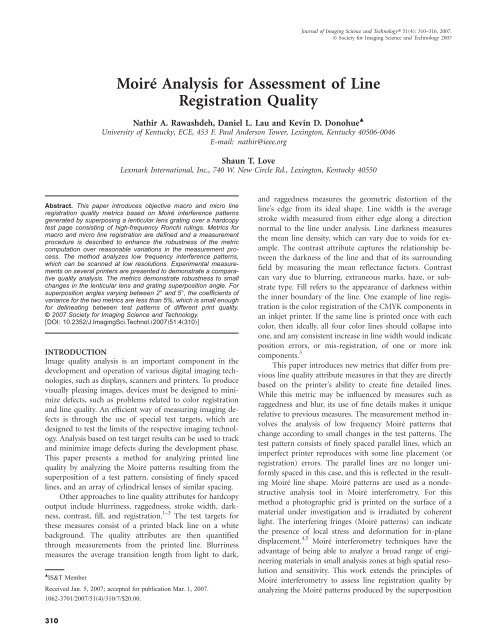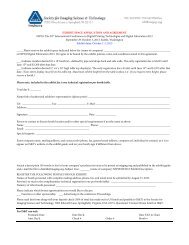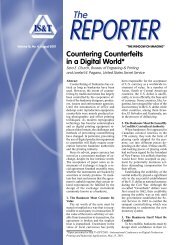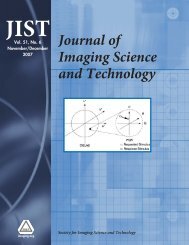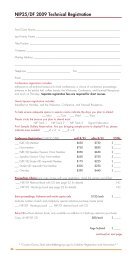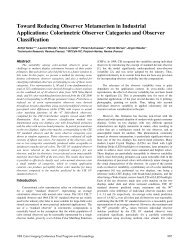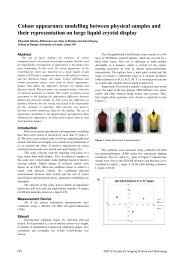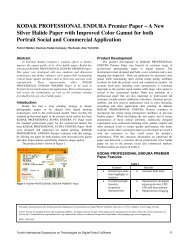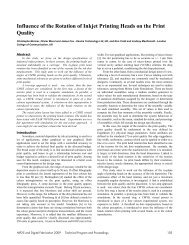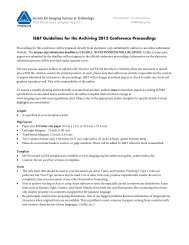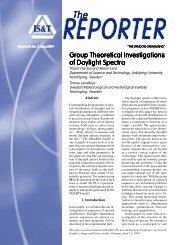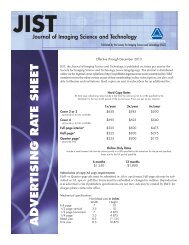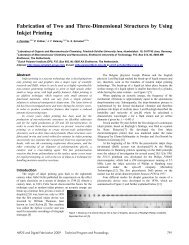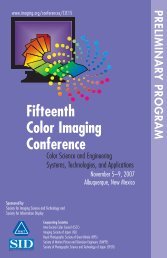Additional Material, Journal of Imaging Science - Society for Imaging ...
Additional Material, Journal of Imaging Science - Society for Imaging ...
Additional Material, Journal of Imaging Science - Society for Imaging ...
You also want an ePaper? Increase the reach of your titles
YUMPU automatically turns print PDFs into web optimized ePapers that Google loves.
<strong>Journal</strong> <strong>of</strong> <strong>Imaging</strong> <strong>Science</strong> and Technology® 51(4): 310–316, 2007.<br />
© <strong>Society</strong> <strong>for</strong> <strong>Imaging</strong> <strong>Science</strong> and Technology 2007<br />
Moiré Analysis <strong>for</strong> Assessment <strong>of</strong> Line<br />
Registration Quality<br />
Nathir A. Rawashdeh, Daniel L. Lau and Kevin D. Donohue <br />
University <strong>of</strong> Kentucky, ECE, 453 F. Paul Anderson Tower, Lexington, Kentucky 40506-0046<br />
E-mail: nathir@ieee.org<br />
Shaun T. Love<br />
Lexmark International, Inc., 740 W. New Circle Rd., Lexington, Kentucky 40550<br />
Abstract. This paper introduces objective macro and micro line<br />
registration quality metrics based on Moiré interference patterns<br />
generated by superposing a lenticular lens grating over a hardcopy<br />
test page consisting <strong>of</strong> high-frequency Ronchi rulings. Metrics <strong>for</strong><br />
macro and micro line registration are defined and a measurement<br />
procedure is described to enhance the robustness <strong>of</strong> the metric<br />
computation over reasonable variations in the measurement process.<br />
The method analyzes low frequency interference patterns,<br />
which can be scanned at low resolutions. Experimental measurements<br />
on several printers are presented to demonstrate a comparative<br />
quality analysis. The metrics demonstrate robustness to small<br />
changes in the lenticular lens and grating superposition angle. For<br />
superposition angles varying between 2° and 5°, the coefficients <strong>of</strong><br />
variance <strong>for</strong> the two metrics are less than 5%, which is small enough<br />
<strong>for</strong> delineating between test patterns <strong>of</strong> different print quality.<br />
© 2007 <strong>Society</strong> <strong>for</strong> <strong>Imaging</strong> <strong>Science</strong> and Technology.<br />
DOI: 10.2352/J.<strong>Imaging</strong>Sci.Technol.200751:4310<br />
INTRODUCTION<br />
Image quality analysis is an important component in the<br />
development and operation <strong>of</strong> various digital imaging technologies,<br />
such as displays, scanners and printers. To produce<br />
visually pleasing images, devices must be designed to minimize<br />
defects, such as problems related to color registration<br />
and line quality. An efficient way <strong>of</strong> measuring imaging defects<br />
is through the use <strong>of</strong> special test targets, which are<br />
designed to test the limits <strong>of</strong> the respective imaging technology.<br />
Analysis based on test target results can be used to track<br />
and minimize image defects during the development phase.<br />
This paper presents a method <strong>for</strong> analyzing printed line<br />
quality by analyzing the Moiré patterns resulting from the<br />
superposition <strong>of</strong> a test pattern, consisting <strong>of</strong> finely spaced<br />
lines, and an array <strong>of</strong> cylindrical lenses <strong>of</strong> similar spacing.<br />
Other approaches to line quality attributes <strong>for</strong> hardcopy<br />
output include blurriness, raggedness, stroke width, darkness,<br />
contrast, fill, and registration. 1–3 The test targets <strong>for</strong><br />
these measures consist <strong>of</strong> a printed black line on a white<br />
background. The quality attributes are then quantified<br />
through measurements from the printed line. Blurriness<br />
measures the average transition length from light to dark,<br />
<br />
IS&T Member<br />
Received Jan. 5, 2007; accepted <strong>for</strong> publication Mar. 1, 2007.<br />
1062-3701/2007/514/310/7/$20.00.<br />
and raggedness measures the geometric distortion <strong>of</strong> the<br />
line’s edge from its ideal shape. Line width is the average<br />
stroke width measured from either edge along a direction<br />
normal to the line under analysis. Line darkness measures<br />
the mean line density, which can vary due to voids <strong>for</strong> example.<br />
The contrast attribute captures the relationship between<br />
the darkness <strong>of</strong> the line and that <strong>of</strong> its surrounding<br />
field by measuring the mean reflectance factors. Contrast<br />
can vary due to blurring, extraneous marks, haze, or substrate<br />
type. Fill refers to the appearance <strong>of</strong> darkness within<br />
the inner boundary <strong>of</strong> the line. One example <strong>of</strong> line registration<br />
is the color registration <strong>of</strong> the CMYK components in<br />
an inkjet printer. If the same line is printed once with each<br />
color, then ideally, all four color lines should collapse into<br />
one, and any consistent increase in line width would indicate<br />
position errors, or mis-registration, <strong>of</strong> one or more ink<br />
components. 3<br />
This paper introduces new metrics that differ from previous<br />
line quality attribute measures in that they are directly<br />
based on the printer’s ability to create fine detailed lines.<br />
While this metric may be influenced by measures such as<br />
raggedness and blur, its use <strong>of</strong> fine details makes it unique<br />
relative to previous measures. The measurement method involves<br />
the analysis <strong>of</strong> low frequency Moiré patterns that<br />
change according to small changes in the test patterns. The<br />
test pattern consists <strong>of</strong> finely spaced parallel lines, which an<br />
imperfect printer reproduces with some line placement (or<br />
registration) errors. The parallel lines are no longer uni<strong>for</strong>mly<br />
spaced in this case, and this is reflected in the resulting<br />
Moiré line shape. Moiré patterns are used as a nondestructive<br />
analysis tool in Moiré interferometry. For this<br />
method a photographic grid is printed on the surface <strong>of</strong> a<br />
material under investigation and is irradiated by coherent<br />
light. The interfering fringes (Moiré patterns) can indicate<br />
the presence <strong>of</strong> local stress and de<strong>for</strong>mation <strong>for</strong> in-plane<br />
displacement. 4,5 Moiré interferometry techniques have the<br />
advantage <strong>of</strong> being able to analyze a broad range <strong>of</strong> engineering<br />
materials in small analysis zones at high spatial resolution<br />
and sensitivity. This work extends the principles <strong>of</strong><br />
Moiré interferometry to assess line registration quality by<br />
analyzing the Moiré patterns produced by the superposition<br />
310


